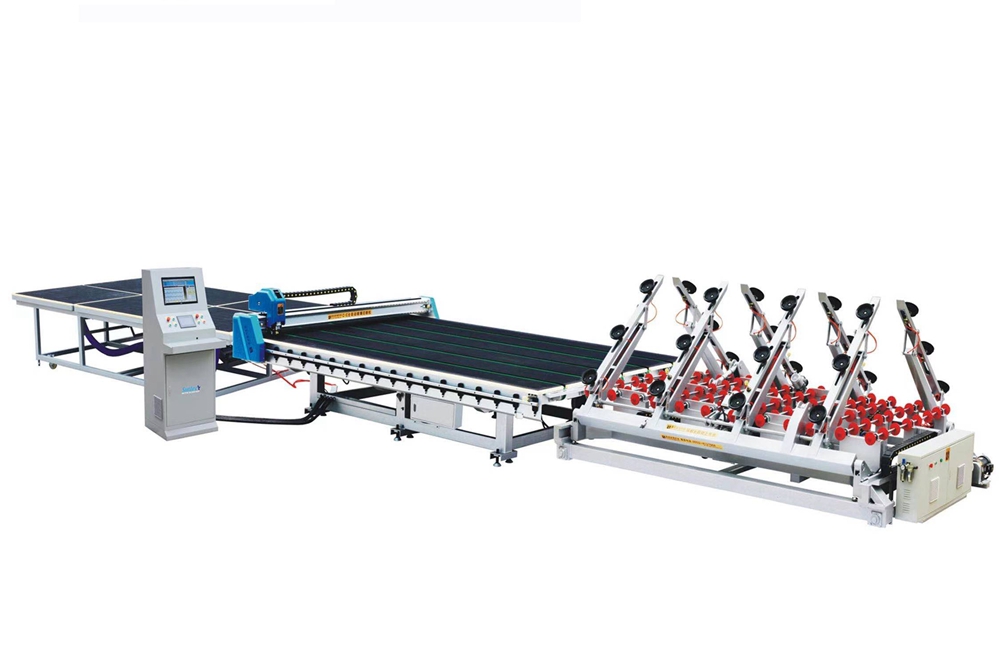Glass processing is a critical industry that spans various sectors, including construction, automotive, and consumer electronics. Different types of glass processing machines play a vital role in transforming raw glass into finished products with specific shapes, sizes, and properties. LAD Glass Machinery offers a wide range of glass processing machines, and below we introduce the four basic glass processing machines: the glass tempering machine, glass cutting machine & table, glass edging machine, and glass drilling machine.
Glass Tempering Machine
Glass tempering is a process that involves heating glass to a high temperature and then rapidly cooling it to create a toughened glass that is stronger and safer than regular annealed glass. The glass tempering machine is designed to carry out this process efficiently and consistently.
A typical glass tempering machine consists of a heating furnace, a quenching section, and a conveyor system. The heating furnace heats the glass to temperatures exceeding 600°C, which softens the glass. The glass is then quickly moved to the quenching section, where high-pressure air jets cool it rapidly. This rapid cooling creates a balance of tensile and compressive stresses within the glass, significantly increasing its strength.
Tempered glass is used in various applications, including automotive windows, shower doors, and building facades, due to its safety characteristics. When broken, it shatters into small, blunt pieces rather than sharp shards, reducing the risk of injury. Regular maintenance of the glass tempering machine, such as ensuring proper calibration and cleaning the air nozzles, is essential for maintaining the quality and safety of the tempered glass.
Glass Cutting Machine & Table
Glass cutting is one of the most fundamental processes in glass manufacturing. A glass cutting machine, often accompanied by a cutting table, is designed to score and break the glass into desired shapes and sizes. These machines can be manual, semi-automatic, or fully automatic, depending on the level of precision and production volume required.
The basic principle of glass cutting involves scoring the glass surface with a diamond or carbide wheel, creating a controlled crack. The glass is then snapped along this score line, resulting in a clean break. Modern glass cutting machines use CNC (Computer Numerical Control) technology to achieve precise cuts with minimal waste. The cutting table provides a stable surface for the glass, often equipped with an air flotation system to facilitate easy handling of large glass sheets.
Automation in glass cutting machines enhances accuracy and efficiency, allowing for intricate shapes and patterns to be cut with high precision. These machines are widely used in industries ranging from architectural glass production to the manufacturing of electronic displays. Regular calibration of the cutting wheel and proper maintenance of the table's surface are crucial for achieving consistent cutting quality.
Glass Edging Machine
After cutting, the edges of the glass are often rough and sharp, requiring further processing to ensure safety and aesthetics. This is where the glass edging machine comes into play. Glass edging machines smooth and polish the edges of the glass, preparing it for further use or assembly.
There are different types of glass edging machines, including flat edging machines, pencil edging machines, and beveled edging machines. Flat edging machines create straight, smooth edges, while pencil edging machines produce a rounded, smooth edge. Beveled edging machines cut a specific angle into the edge, adding a decorative touch.
The process involves feeding the glass through a series of grinding wheels or belts, which gradually remove the rough edges and polish the glass. Advanced edging machines can handle multiple glass pieces simultaneously, significantly improving production efficiency. Proper maintenance, such as regularly replacing worn grinding wheels and keeping the machine clean, ensures the edging machine operates effectively and produces high-quality results.
Glass Drilling Machine
Glass drilling is another critical process, especially for applications requiring holes for fixtures, fittings, or wiring. A glass drilling machine is specifically designed to drill precise holes in glass without causing cracks or breaks. These machines use diamond-tipped drill bits, which are capable of cutting through the hard glass material with minimal pressure.
The glass drilling process typically involves placing the glass on a stable surface and using a water cooling system to lubricate the drill bit and glass. The water cooling system also helps to dissipate the heat generated during drilling, preventing thermal stress that can lead to cracking.
Glass drilling machines can be manual or CNC-controlled, with the latter offering higher precision and the ability to perform complex drilling patterns. These machines are commonly used in the production of mirrors, glass doors, and electronic display panels. Regular maintenance, such as checking the alignment of the drill bit and ensuring the cooling system is functioning correctly, is essential for maintaining the machine's performance and extending its lifespan.
Conclusion
Understanding the different types of glass processing machines is crucial for anyone involved in the glass manufacturing industry. Each machine—glass tempering, cutting, edging, and drilling—plays a unique role in transforming raw glass into finished products that meet specific standards and applications. Proper maintenance and operation of these machines are vital for ensuring product quality, safety, and efficiency. By investing in the right equipment and adhering to best practices in maintenance, manufacturers can achieve optimal performance and longevity from their glass processing machinery.
